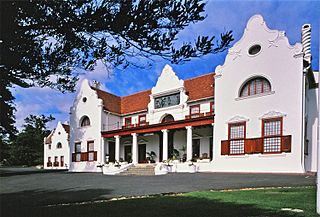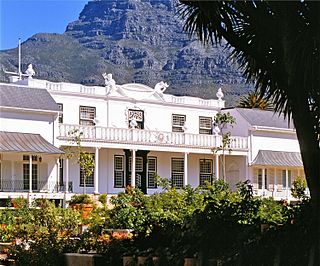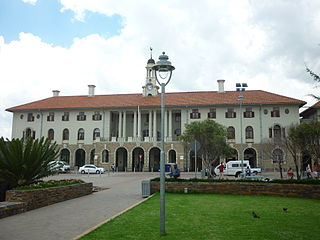
Sir Edwin Landseer Lutyens was an English architect known for imaginatively adapting traditional architectural styles to the requirements of his era. He designed many English country houses, war memorials and public buildings. In his biography, the writer Christopher Hussey wrote, "In his lifetime (Lutyens) was widely held to be our greatest architect since Wren if not, as many maintained, his superior". The architectural historian Gavin Stamp described him as "surely the greatest British architect of the twentieth century".

The Union Buildings form the official seat of the South African Government and also house the offices of the President of South Africa. The imposing buildings are located in Pretoria, atop Meintjeskop at the northern end of Arcadia, close to historic Church Square. The large gardens of the Buildings are nestled between Government Avenue, Vermeulen Street East, Church Street, the R104 and Blackwood Street. Fairview Avenue is a closed road through which only officials can enter the Union Buildings. Though not in the centre of Pretoria, the Union Buildings occupy the highest point of Pretoria, and constitute a South African national heritage site.

The Rashtrapati Bhavan is the official residence of the President of India at the western end of Rajpath, Raisina Hill, New Delhi, India. It was formerly known as Viceroy's House and constructed during the zenith of British Empire. Rashtrapati Bhavan may refer to only the 340-room main building that has the president's official residence, including reception halls, guest rooms and offices, also called the mansion; it may also refer to the entire 130-hectare (320-acre) Presidential Estate that additionally includes the presidential gardens, large open spaces, residences of bodyguards and staff, stables, other offices and utilities within its perimeter walls. In terms of area, it is the second largest residence of any head of state in the world after Quirinal Palace in Italy. The other presidential homes are the Rashtrapati Nilayam in Hyderabad, Telangana and The Retreat Building in Shimla, Himachal Pradesh.
The following lists events that happened during 1902 in South Africa.

Sir Herbert Baker was an English architect remembered as the dominant force in South African architecture for two decades, and a major designer of some of New Delhi's most notable government structures. He was born and died at Owletts in Cobham, Kent.

Pretoria Boys High School is a public, tuition-charging, English-medium high school for boys situated in the suburb of Brooklyn in Pretoria in the Gauteng province of South Africa, founded in 1901 by Alfred Milner, 1st Viscount Milner.

Groote Schuur is an estate in Cape Town, South Africa. In 1657, the estate was owned by the Dutch East India Company which used it partly as a granary. Later, the farm and farmhouse was sold into private hands. Groote Schuur was later acquired by William De Smidt, and remained in the family's possession until it was sold by Abraham De Smidt, Surveyor General of the Cape Colony, in 1878, and was bought by Hester Anna van der Byl of the prominent Van Der Byl / Coetsee family. In 1891 Cecil Rhodes leased it from her. He later bought it from her in 1893 for £60 000, and had it converted and refurbished by the architect Sir Herbert Baker. The Cape Dutch building, located in Rondebosch, on the slopes of Devil's Peak, the outlying shoulder of Table Mountain, was originally part of the Dutch East India Company's granary constructed in the seventeenth century.

The Secretariat Building or Central Secretariat houses the important ministries of the Government of India. Situated at Raisina Hill, New Delhi, the Secretariat buildings are two blocks of symmetrical buildings on opposite sides of the great axis of Kartavya Path, and flanking the Rashtrapati Bhavan.

De Tuynhuys is the office of the president of South Africa, located in Cape Town.

Cape Dutch architecture is an architectural style found mostly in the Western Cape of South Africa, but modern examples of the style have also been exported as far afield as Western Australia and New Zealand, typically on wine estates. The style was prominent in the early days of the Cape Colony, and the name derives from the initial settlers of the Cape being primarily Dutch. The style has roots in medieval Netherlands, Germany, France and Indonesia.

Potchefstroom High School for Boys is a public English medium high school for boys situated in Potchefstroom in the North West province of South Africa. It is one of the oldest schools in South Africa.

Lutyens' Delhi is an area in New Delhi, India, named after the British architect Sir Edwin Lutyens (1869–1944), who was responsible for much of the architectural design and building during the period of the British Raj, when India was part of the British Empire in the 1920s and 1930s and 1940s. This also includes the Lutyens Bungalow Zone (LBZ).

Pretoria railway station is the central station in Pretoria, the executive capital of South Africa. It is located between Pretoria's central business district and Salvokop, in a 1910 building designed by Herbert Baker. It is the terminus of various Metrorail commuter rail services in the northern part of Gauteng, and a stop on Shosholoza Meyl inter-city services from Johannesburg to Polokwane and Nelspruit. Pretoria is also the northern terminus of the luxury Blue Train service from Cape Town. Platforms and tracks for the Gautrain rapid-rail service are adjacent to the main-line station.

The mansions of Parktown are an important part of the history of the city of Johannesburg. They were the homes of the Randlords, accountants, military personnel and other influential residents of early Johannesburg, dating back as early as the 1890s. The first of these mansions, Hohenheim was designed by Frank Emley and was built for Sir Lionel Phillips and his wife Lady Florence Phillips. The name Hohenheim had been used originally by Hermann Eckstein, one of the first Rand Lords to name his house after the place of his own birth. When Phillips became the head of Eckstein & Co, he moved in to Eckstein's house but due to the expansion of the city decided to build the new Hohenheim in an enviable site further from the mine workings. Sir Lionel Phillips was banished from the Republic for his involvement in the Jameson Raid. It is perhaps fitting that the next occupant of this famous house was none other than Sir Percy Fitzpatrick, the author of the best selling book 'Jock of the Bushveldt'. The house was demolished but a plaque remains in honor of this building.

The Houses of Parliament of South Africa are situated in Cape Town. The building consists of three main sections: the original building, completed in 1884, and additions constructed in the 1920s and 1980s. The newer additions house the National Assembly, and the original building houses the National Council of Provinces.

The South African War Memorial is a First World War memorial in Richmond Cemetery in the London Borough of Richmond upon Thames. Designed by architect Sir Edwin Lutyens, the memorial is in the form of a cenotaph, similar to that on Whitehall, also by Lutyens. It was commissioned by the South African Hospital and Comforts Fund Committee to commemorate the 39 South African soldiers who died of their wounds at a military hospital in Richmond Park during the First World War. The memorial was unveiled by General Jan Smuts in 1921 and was the focus of pilgrimages from South Africa through the 1920s and 1930s, after which it was largely forgotten until the 1980s when the Commonwealth War Graves Commission took responsibility for its maintenance. It has been a grade II listed building since 2012.

The Empire Exhibition, South Africa, held in Johannesburg, was intended to mark that city's jubilee and was opened by the Governor-General of the Union of South Africa on 15 September 1936. It was the first exhibition held in the Union of South Africa following two earlier exhibitions in Cape Colony in 1877 and 1892. The idea of an empire exhibition in South Africa was first discussed in 1934 by the Buy Empire Committee of Johannesburg. On 9 January 1935, the Grand Council of the Federation of British Industries passed a resolution for a proposal to hold an Empire Exhibition in Johannesburg in 1936 in conjunction with the Golden Jubilee of the city.
The Architecture of Delhi dates back more than a thousand years. As the capital of several great empires of India, including Rajput kingdom, Delhi Sultanate, Mughal Empire, and British Raj, the city of Delhi has been a centre for art and architecture.
Ernest Willmot Sloper was an architect active in Johannesburg, South Africa and in the United Kingdom. He designed Bishopskop for Michael Furse, bishop of Pretoria. He also designed his own house in Parktown, Endstead

The Mandela Rhodes Building is a Cape Dutch revival building situated in Cape Town, South Africa.

















